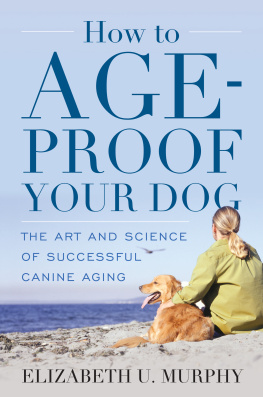through a
Dogs Ear
Using Sound to Improve
the Health & Behavior
of Your Canine Companion
JOSHUA LEEDS
&
SUSAN WAGNER, DVM, MS

Enhanced Contents
Contents

A New Sound Awareness
W hen I first visited New York City, my fiance proudly greeted me with Rita, her cherished year-old Japanese Akita. A statuesque and soulful dog of nearly 100 pounds, Rita was just what Margaret needed: a business watchdog, a protector while walking the Manhattan streets, and a truly faithful, loving companion.
Be careful when you let her off the leash, was the only warninga caution that rang in my ears a few weeks later as I permitted Rita to walk unencumbered through Riverside Park. This little bit of green was Ritas favorite haunt, just a few blocks from our apartment. Our experience, like that of most dog walkers, was that our dog loved her few minutes of freedom from human restriction. She would get a little skittish at times, but would always come when called. That night, however, all it took was the sound from an unseen cars tailpipe backfiring to send Rita off like a shot, running frantically for the safety of home. The only problem was four lanes of fast yellow taxis on Broadway between the park and our apartment.
Rita! Rita! Rita! I screamed as I ran after her in the chilly night. She was one block ahead and fast outpacing me. Two blocks later, I was still running as fast as I could after Rita, who was running as fast as she could toward Broadway.
Riiiitttttaaaaaa!
Suddenly there was the sound of horns, followed by skidding tires, a loud whack!, and then that pit-in-the-stomach quietthe kind of stillness where everything starts going in slow motion. As I turned the corner, my worst nightmare awaited me. Rita was motionless on the asphalt, a taxi driver who didnt speak English was gesturing wildly, and people were coming out of the shops and restaurants to see what had happened.
When I reached her side, I looked for movement in her bellyfor any sign of breath. Yes! She was still breathing. Next, I looked into her eyes but didnt get the same reassurancethey were wide open, watering, and full of fear, pain, and I dont know what. I shouted out a telephone number and a neighbor called my fiance, who arrived within moments. She placed gentle and quivering hands on Ritas face, running them slowly down her neck and body. No blood or exposed bones, thank goodnessa miracle, considering the size of the dent Rita had left on the yellow taxi, which had now left us alone in the middle of the street. We put Ritas leash back on and slowly coaxed her back to her feet. She could stand upsort ofand we helped her into another cab. Eight long minutes later, Rita hobbled into the emergency animal hospital for x-rays and observation and, for us, an anxious night of waiting.

Rita the Akita with Lyric Tucker-Leeds
Rita came home the next evening with lots of pain medication and a diagnosis of severely bruised ribs but no apparent organ damage. Because of her size and young age, she had miraculously survived being hit at 40 miles per hour! Many years later, we discovered that several of her vertebrae had fused together due to the injury. Nonetheless, Rita lived almost a full decade after the accident.
For years, when I thought back on that most painful Manhattan night, I wondered how it was possible that one seemingly insignificant and distant sound could have shocked such a large, professionally trained animal into bolting for home. What went through this dogs ear? It took me two decades to figure it out. Although powerful and large, Rita was high-strung; she had a very sensitive nervous system. And as with people who are sensitive to noise, it didnt take much to upset her balance and cause her to seek the shelter of home.
CANINES IN THE COAL MINE
As Ritas accident illustrates, over-stimulation of auditory senses can have as significant an effect on our animals as it does on humans. While there is no official diagnosis of noise disease, millions of people suffer from dysfunctional auditory processing or from the inability to control their environments. Through a Dogs Ear explores a similarity between human and canine auditory perception, and investigates the effects of the human soundscape on our canine companions.
I am privileged to write this book with Dr. Susan Wagner, veterinary neurologist, academician, and holistic practitioner of animals and humans. Her focus on the spiritual nature of animals and the connection between human and animal welfare issues informs her perspective throughout.
In Through a Dogs Ear, we explore whats known about sound and dogs, compare current research into music and canine behavior, and begin the process of connecting the dots of a picture that has not been painted before. In the end, the picture reveals a new kind of canary in the coal mine: the behavioral problems in our dogs forewarn of a much larger problem in the human soundscape, a problem that is affecting us as much as it influences them. In fact, we believe that many anxiety behaviors common in both the American people and their dogs may be the result of cumulative sensory overload, starting with the sound environments in which we live.
Is it possible that the uptick in psychological and physiological dysfunctions were now observing in the canine population may be a reaction to our ever more media-driven, high-tech, 24-7 culture? Is this same environment a direct cause of the increased spread of stress- and environment-related maladies in humans, as well?
Research has shown that dogs are among the most adaptable of animals. Most dog guardians have thus assumed that it is the dogs job to adjust to whatever environment we offer themno matter how stressful. In this case, perhaps our dogs willingness to do anything for us has become their Achilles heelthe result of their total compliance is that canines are more stressed than ever before.
CANINE BEHAVIORAL ISSUES: AN OVERWHELMING PROBLEM?
As many as 90 percent of people who bring their dogs to a vet discuss some type of canine behavioral issue. To put this in perspective, one out of every seven American dogs currently suffers when left alone or separated from their main person(s).
At the opposite end of the behavioral spectrum is aggression, a complex issue. In 1994, an estimated 4.7 million Americans were bitten, with 6,000 hospitalized.
The link between interpersonal violence and animal cruelty is an area important to the authors and worthy of everyones attention. If you would like to learn more, visit www.ThroughADogsEar.com.
Through a Dogs Ear suggests that we examine our environments to determine if we are creating the best sensory space possible to support behavioral balance and health in our dogsand, subsequently, in ourselves. These concepts should not be construed as a pampering; rather, they are about finding solutions to the growing problem of constant stimulationan issue few have recognized. Who would have thought that simplified music could be part of the solution for de-stressing our best furry friends?
PSYCHOACOUSTICS MEETS BIOACOUSTICS
An official definition of psychoacoustics is a branch of science dealing with hearing, the sensations produced by sounds, and the problems of communication. Psychoacoustics may also be thought of as the study of the perception of sound.
Next page











